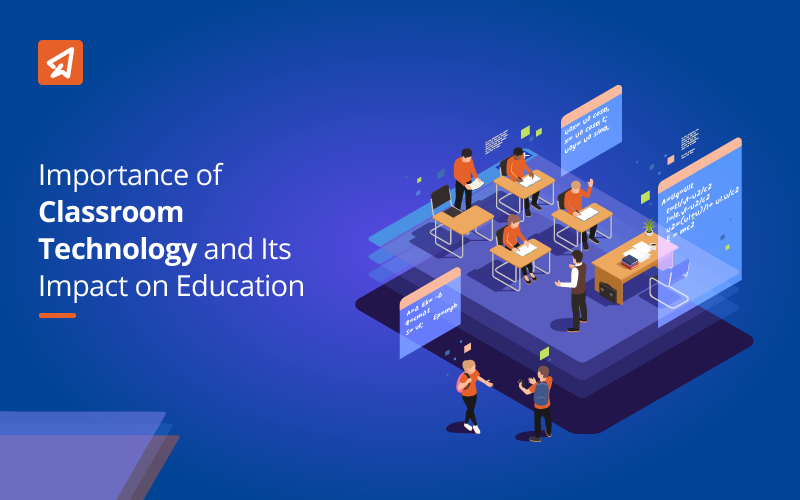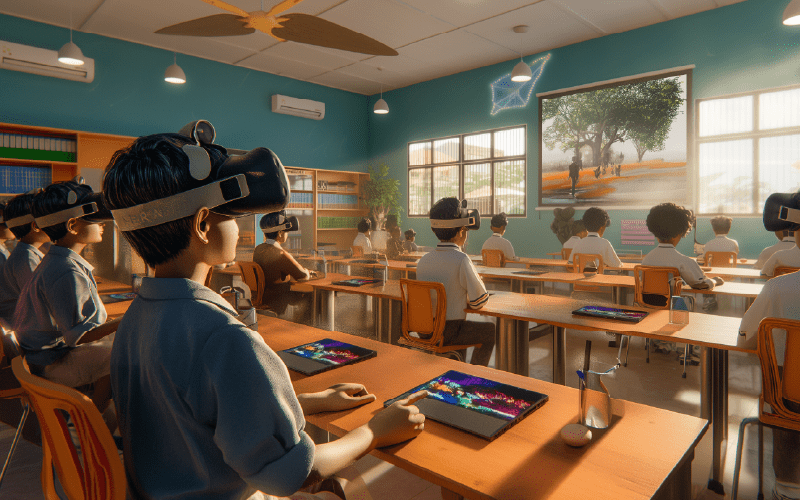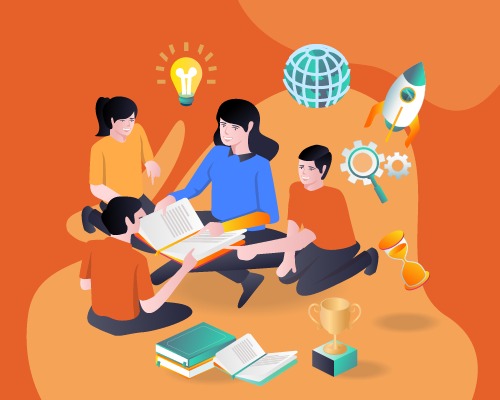Top 8 Technology Tools for the Classroom: Impact & Advantages

The quality of education that can be offered to a student is intrinsically tied to the technology available at the time. With the advancement of technology, the classroom has also evolved over the years. Along with the traditional blackboards and chalks, now digital whiteboards and tablets, technology has transformed the way teachers teach and students learn. Smart classrooms have become a popular trend in the education sector, and education technology has become an integral part of the modern-day classroom.
School owners and administrators must understand the objectives of education technology and stay up-to-date with the latest trends to ensure that their school offers the best-personalised learning experience for their students. Let’s take a deep dive into the world of classroom technology, understand the technologies that can be used in the education sector, and recognise its impact on student learning.
What is Classroom Technology?
Classroom technology is all about using gadgets and computer programs to make learning in school more interesting and effective. This can include devices like computers, smart boards, tablets, and online tools that help teachers and students. It makes learning more interactive, lets students learn at their own pace, and allows teachers to have more resources for their lessons. This technology also helps with things like online tests and homework. It’s a big part of today’s education, making it easier for both teachers and students to learn and teach.

Impact of Classroom Technology on Student Learning
The impact of technology on student learning has been widely studied and debated in recent years. There is growing evidence that it can have a positive impact on student learning outcomes. Technology in the classroom can help improve student engagement, increase collaboration, facilitate personalised learning experiences, enhance access to information, and improve assessment. It can also help to prepare students for the increasingly digital world in which they will live and work.
In line with this, India’s National Education Policy (NEP) emphasizes the integration of technology in education to enhance learning experiences. The NEP advocates for the use of digital tools to enable equitable access to quality education, promote adaptive learning, and support teachers in creating interactive and engaging classroom environments. By leveraging technology, schools and institutions can align with NEP’s vision of transforming education through innovation and digital inclusion.
-
Remote Learning Platforms
The global shift toward remote learning has transformed the traditional classroom, allowing students to access education from any location. With the help of video conference platforms like Zoom, Teams, and Google Meet, students can participate in virtual classrooms, ensuring uninterrupted learning experiences despite external challenges or restrictions.
-
Tablets
Tablets are everywhere, and now they’re in the classroom, too. They often replace notebooks and textbooks, saving paper and keeping all your work in one place. They make learning more engaging and are easier to use than traditional computer setups. Common tablets in the classroom include the iPad Mini, XiaomiPad, and Samsung Galaxy Tab.
-
Smart Boards
Smart boards have revolutionised classroom interactions, providing an interactive platform for teachers and students to engage with educational content. These large, interactive projector screens facilitate dynamic learning experiences, enabling students to actively participate in lessons and collaborate with their peers.
To learn more about why you should use a digital smart board for teaching, read our blog on it.
-
Virtual Reality
Imagine exploring the world from your classroom. Virtual reality (VR) makes it possible. With VR headsets, students can take virtual trips to historical sites, museums, and distant lands. This immersive experience enhances learning in subjects like art, science, and history, making education more exciting.
-
Digital Pads
Digital pads are a dream come true for aspiring artists and students interested in digital design. These handy devices, like the iPad Pro with Apple Pencil, the Wacom Intuos, or the Huion H420, enable students to create digital drawings and designs. Plus, they reduce paper waste by providing a limitless digital canvas.
-
Game-based Learning
Kids love video games, and they can be a great teaching tool. Game-based learning keeps students engaged and improves their memory and hand-eye coordination. Plus, it’s a gateway to learning how to create and code games, a valuable skill in the growing gaming industry.
Read our blog for Ideas to Implement Gamification in Education.
-
E-Books
E-books are like regular books but in digital form. Students can read them on phones, tablets, or E-Readers. They’re cost-effective, as you can store many books on a single device. Plus, they help reduce waste since old books are often thrown away when they’re not needed anymore.
-
Document Camera
The document camera is a new addition to classrooms. It projects paper documents, objects, or images onto projectors and smartboards. It’s especially handy in science classes, where it’s used to display experiments and save students from crowding around.
11 Advantages of Integrating Technology in the Classroom
-
Improves Student Engagement and Interactivity in the Classroom
One of the most significant advantages of technology in the classroom is that it helps to create a more engaging and interactive learning environment. Teachers can use various digital tools such as interactive whiteboards, educational software, and online quizzes to make the learning experience more enjoyable for students. These tools also help capture students’ attention and increase their learning motivation.
This technology helps teachers create personalised and interactive lessons. With the use of multimedia tools, teachers can make abstract concepts more tangible and accessible, which helps students understand and retain the information better. Interactive platforms like Extramarks Smart Class Plus offer teachers real-time actionable feedback on their students’ understanding so they can adapt their lessons accordingly.
-
Drives Academic Success with Exciting Learning Resources
Technology in the classroom lets teachers create exciting lessons that students really enjoy. They can use videos, podcasts, and fun animated lessons to make learning interactive and engaging. For example, with Extramarks Smart Class Plus, students can have a blast with game-based modules and cool animated videos that make learning fun.
Besides, technology gives students and teachers access to tons of information from all over the world through the internet. This makes learning flexible so that students can learn at their own pace and when they want to.
Also, digital textbooks and online learning platforms give students easy access to study materials anytime. It’s like having a 24/7 library at your fingertips, making it easier to prepare for exams. Students can also use online resources to explore their interests and learn on their own.
-
Enhances Collaboration and Communication
With the help of technology in education, students now have access to interactive tools like digital whiteboards and video conferencing. This has created a fun and engaging learning environment where students are encouraged to work together on group projects, assignments, and brainstorming sessions. This collaboration boosts their participation and helps them interact more with each other. Teachers also find it easier to communicate with students and parents using emails, messaging apps, and online forums. This makes it simpler for everyone to stay updated and involved in the learning process.
-
Personalises Learning
An important benefit of personalised learning is that it can help foster a growth mindset in students, encouraging them to view their learning as a continuous process of growth and improvement. By providing students with opportunities to set their own learning goals, track their progress, and reflect on their achievements, teachers can help to instil a sense of self-efficacy and empowerment in students.
With Extramarks Smart Class Plus, teachers receive assessments based on each student’s strengths and weaknesses. The platform evaluates each student’s performance and makes suggestions on adjusting the level of difficulty of the material to match their learning pace and level of understanding. This personalised learning approach helps students to progress at their own pace and learn in a way that suits them best, which leads to better engagement and retention of the material.
Discover how personalised learning empowers students to set their own goals and track their progress, fostering a sense of self-efficacy and continuous improvement. Learn more about it here.
-
Makes Assessment More Efficient
Technology can make assessment more efficient and effective. Digital tools such as online quizzes, automated grading, and learning analytics can help teachers assess student progress quickly and accurately, providing students with timely feedback and allowing teachers to identify areas where students may need additional support. This can help teachers monitor student progress more effectively, adjust their teaching strategies as needed, and ensure that students are meeting the learning objectives.
Solutions like Extramarks Smart Class Plus give teachers more detailed data on student performance than traditional assessment methods, enabling them to identify patterns and trends in student learning. This helps them tailor their instruction to individual student needs and provide targeted support.
-
Allows for Flexibility And Accessibility
Technology in the classroom can provide students with more flexibility and accessibility. Online learning platforms can allow students to complete coursework at their own pace, enabling them to take the time they need to fully grasp difficult concepts.
-
Promotes Accessibility and Inclusivity
Using digital tools in the classroom creates a great learning environment that works well for all kinds of students, regardless of their skills or abilities. These tools can make learning easier for students with special needs by helping them join discussions, get their questions answered, and learn more effectively. Some students can use technology like spell checkers and tools that highlight text, which makes their learning experience similar to that of their peers.
There are also technologies like screen readers and captioning tools that make education more accessible for students with disabilities, letting them fully participate in class and learn alongside their classmates. Technology can also connect students from different parts of the world, allowing them to collaborate and learn together in real-time.
-
Prepares Students for the Future
Technology is all around us, and it’s crucial for students to be comfortable with it in their learning environment. When technology is incorporated into teaching, it helps students become familiar with the common tools they’ll use in their future careers.
Teachers have a big responsibility to prepare their students for the challenges of tomorrow. Technology is a great ally in this mission because it will play a significant role in their lives as they grow up. Whether it’s using computers, the internet, or specialised software, these skills will be essential in their future professional and personal endeavours.
-
Accommodates Multiple Learning Styles
Every student is unique and learns at their own pace and in their own way. Technology is a fantastic tool for educators to adapt their teaching methods and customise content to suit the diverse learning styles of their students. It allows for a more personalised and flexible approach to education.
-
Helps in Cost Saving
Technology in the classroom can lead to significant cost savings for schools and educational institutions. By leveraging digital tools and online resources, schools can reduce their reliance on traditional teaching materials such as textbooks, workbooks, and printed handouts. Instead, they can use online resources such as e-books, digital worksheets, and interactive learning platforms, which are often less expensive and more flexible than traditional materials.
Additionally, schools can save money on administrative tasks such as grading and record-keeping by using automated systems, freeing up teachers’ time to focus on teaching and providing support to students.
Furthermore, technology in the classroom can also reduce costs associated with teacher training and professional development. Online training resources and webinars can be less expensive than in-person training sessions while still providing teachers with the knowledge and skills they need to integrate technology effectively into their teaching practice.
11 Ways to Use Technology in the Classroom
-
Interactive Presentations & Content Creation with Multimedia
To make learning more interactive, teachers can create presentations that go beyond traditional slides. Incorporate embedded quizzes and surveys to keep students engaged. Furthermore, assigning projects that involve creating multimedia content such as podcasts, videos, and blogs not only teaches the curriculum but also equips students with valuable digital content creation skills.
-
Storytelling
Encourage creativity and language skills by having students use digital storytelling apps like Book Creator or Storybird on their tablets. This allows them to write and publish their own stories, integrating text, images, and audio for a more immersive narrative experience.
-
Educational Videos
Take advantage of the wealth of educational content available online. Encourage students to watch educational videos on platforms like YouTube or TED-Ed using the smart devices available to them. Afterwards, engage them in critical discussions or have them write reflections on what they’ve learned, enhancing their analytical skills.
-
Save & Share Teaching Resources
Teachers can streamline their teaching by using cloud storage solutions such as Google Drive, Dropbox, or OneDrive. This not only provides a secure backup for teaching materials but also enables easy sharing and access from any location or device, ensuring seamless teaching continuity.
-
Online Discussions and Forums
To enhance digital communication skills, create a class forum using tools like Padlet or Learning Management System (LMS) discussion boards. Students can discuss topics asynchronously, exchange ideas, and build their ability to articulate thoughts in the digital realm.
-
Online Grading/Assessment System
For educators, an online grading and assessment system simplifies the evaluation process. Utilising tools like the Extramarks Assessment Centre, teachers can efficiently assess student performance, provide feedback, and monitor progress with ease.
-
Live Quiz & Game During Lessons
Make lessons more engaging by incorporating live quizzes and interactive games. Platforms like Kahoot! and Quizlet allow teachers to create fun quizzes that help reinforce learning and keep students motivated.
-
Online Mind Mapping
Enhance students’ organisational and brainstorming skills by using online mind-mapping tools. These tools help students visualise and structure their ideas, which is particularly valuable for planning projects and research assignments.
-
Virtual Laboratory Experiments
For science classes, virtual laboratory experiments offer a practical solution. Access to remote labs or virtual experiments allows students to conduct experiments online, providing a safe and convenient way to explore scientific concepts.
-
Virtual Field Trips
Broaden students’ perspectives through virtual field trips accessible via smartboards or VR devices. These online excursions offer a window into places and experiences they might not otherwise have access to. Virtual field trips are an excellent way to make lessons come alive, creating a deeper connection to the subject matter.
-
Homework Assignments
Teachers can assign and collect homework assignments digitally. This streamlines the submission and grading process, making it more convenient for both teachers and students. Additionally, it reduces the risk of lost or misplaced assignments.
Factors That Help Teachers Use Technology in Classroom Efficiently
Technology offers access to unlimited resources that include videos, images, research papers, games, etc., which can turn a conventional learning experience into an engaging one. When technology in the classroom is user-friendly and is implemented effectively, it becomes an extraordinary tool to supplement teaching. Moreover, digital tools like interactive forums, shared documents, video conferencing, interactive whiteboards, etc. encourage peer-to-peer as well as student-teacher collaboration. Classroom technology has also simplified the process of curating lesson plans and made delivering lectures far more efficient and tailored to meet students’ needs.
An integrated academic system empowers teachers to develop engaging instructional practices that help students deepen their understanding of complex topics. Quick access to course material, engaging lessons, efficient student management systems, automated assessments and better student engagement are some ways in which using technology in the classroom benefits teachers. It greatly simplifies a teacher’s job and helps students remain engrossed during lectures with ease, which results in positive learning outcomes.
Technology can also be a valuable asset for schools that are looking to streamline their processes and improve their quality of education for a more definitive and engaging learning experience.
Looking For a Technology Partner To Start Your Journey?
Access to cutting-edge digital tools helps students learn better and become future-prepared by acquiring 21st-century skill sets. Besides, it enables teachers to manage classrooms with ease and curate appropriate lesson plans in a unique and engaging manner.
So, are you ready to explore a world of engaging, collaborative and dynamic classrooms? With Extramarks Smart Class Plus, you can get access to end-to-end tech-enabled classroom learning solutions that are curated to perfection. It has been designed to meet the individual needs of students, teachers, and academic institutions in order to effectively build a collaborative system of learning.
Last Updated on June 25, 2025
Reviewed by

Prachi Singh | VP - Academics
Prachi Singh is a highly accomplished educationist with over 16 years of experience in the EdTech industry. Currently, she plays a pivotal role at Extramarks, leading content strategy and curriculum development initiatives that shape the future of education...read more.











